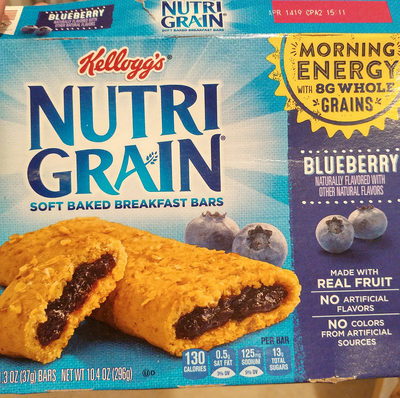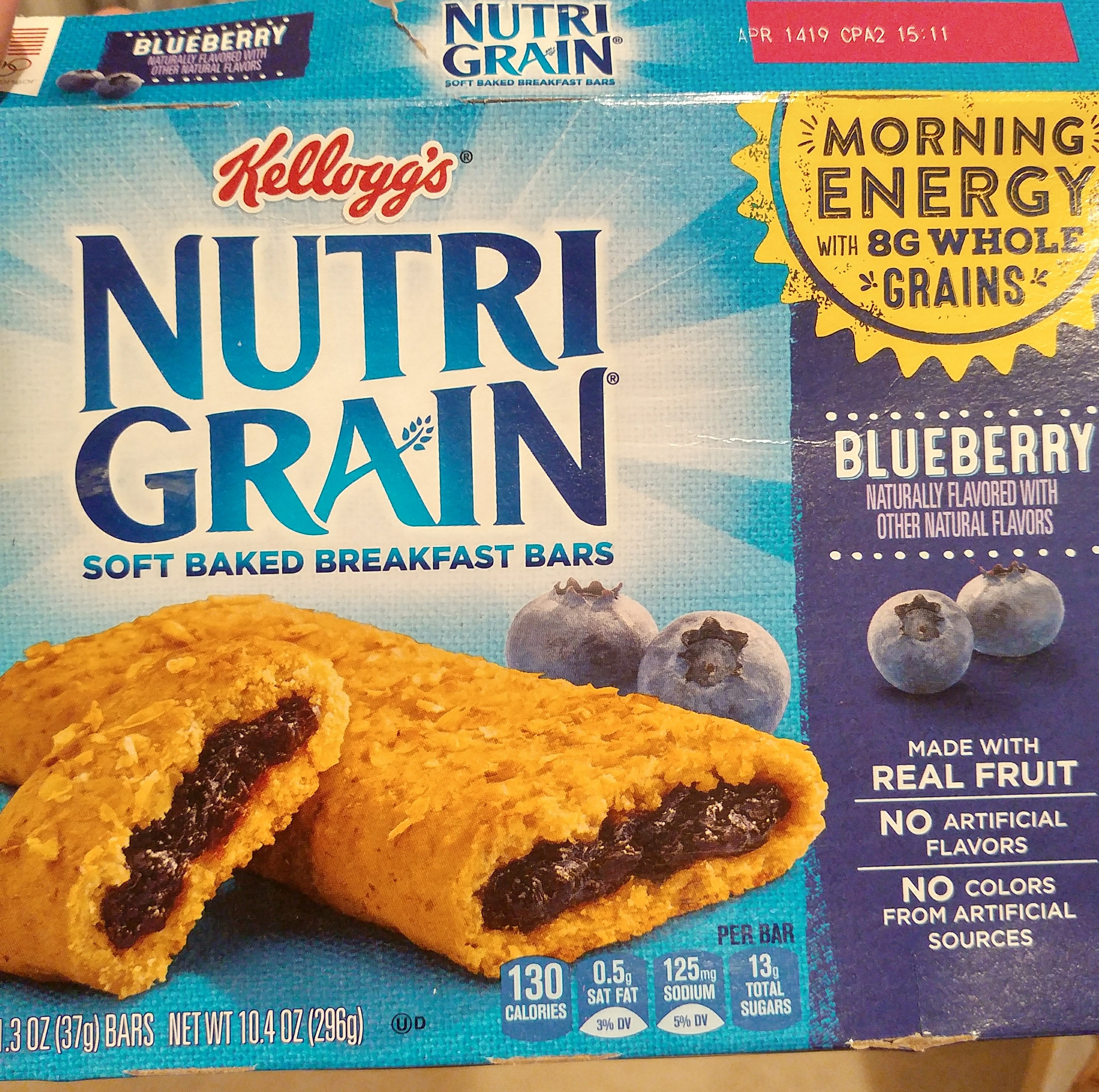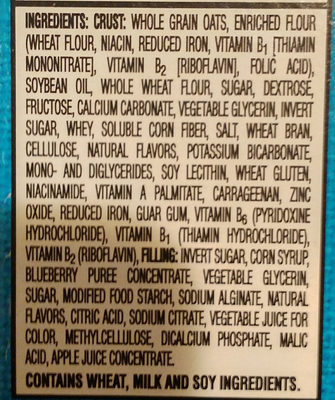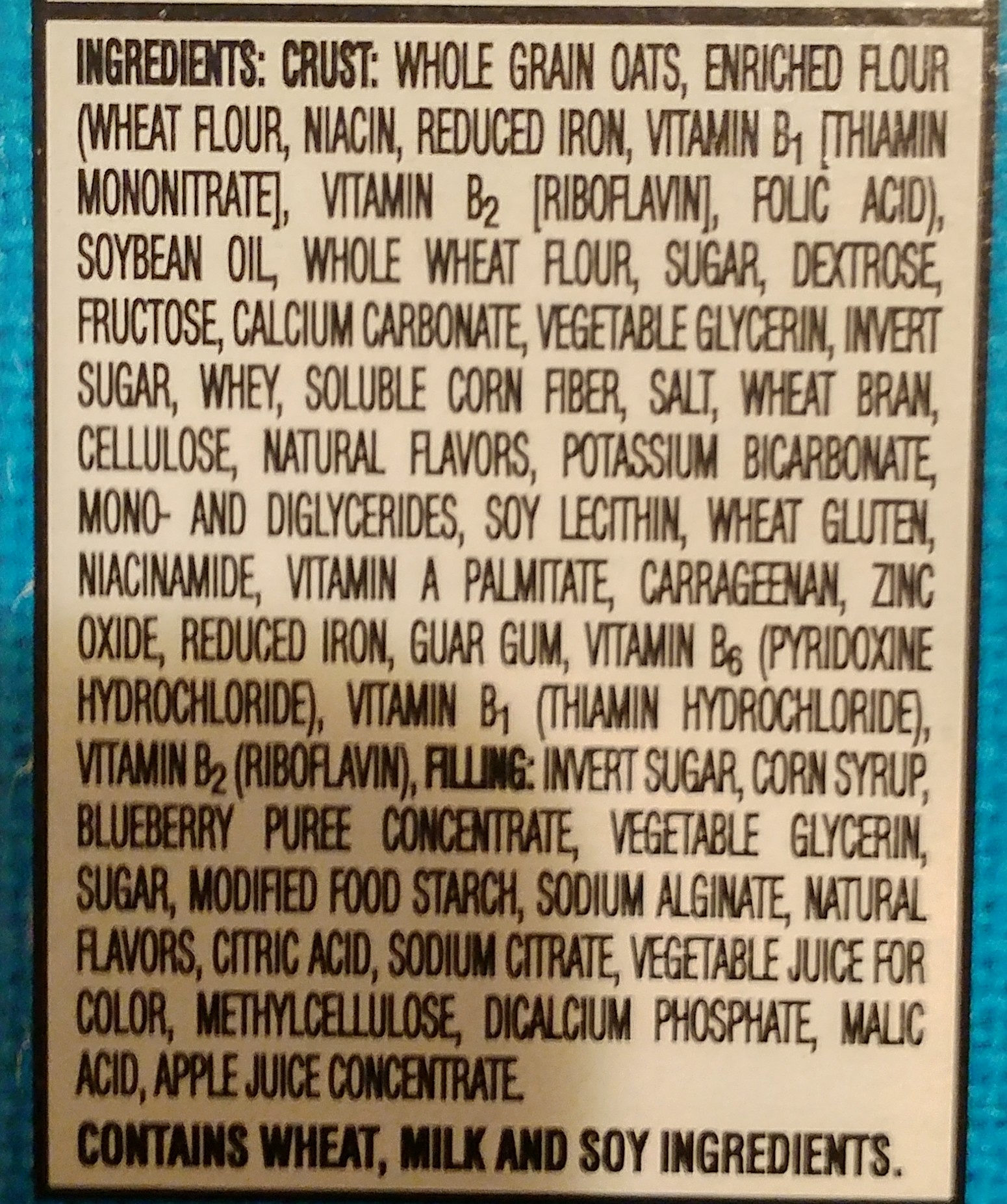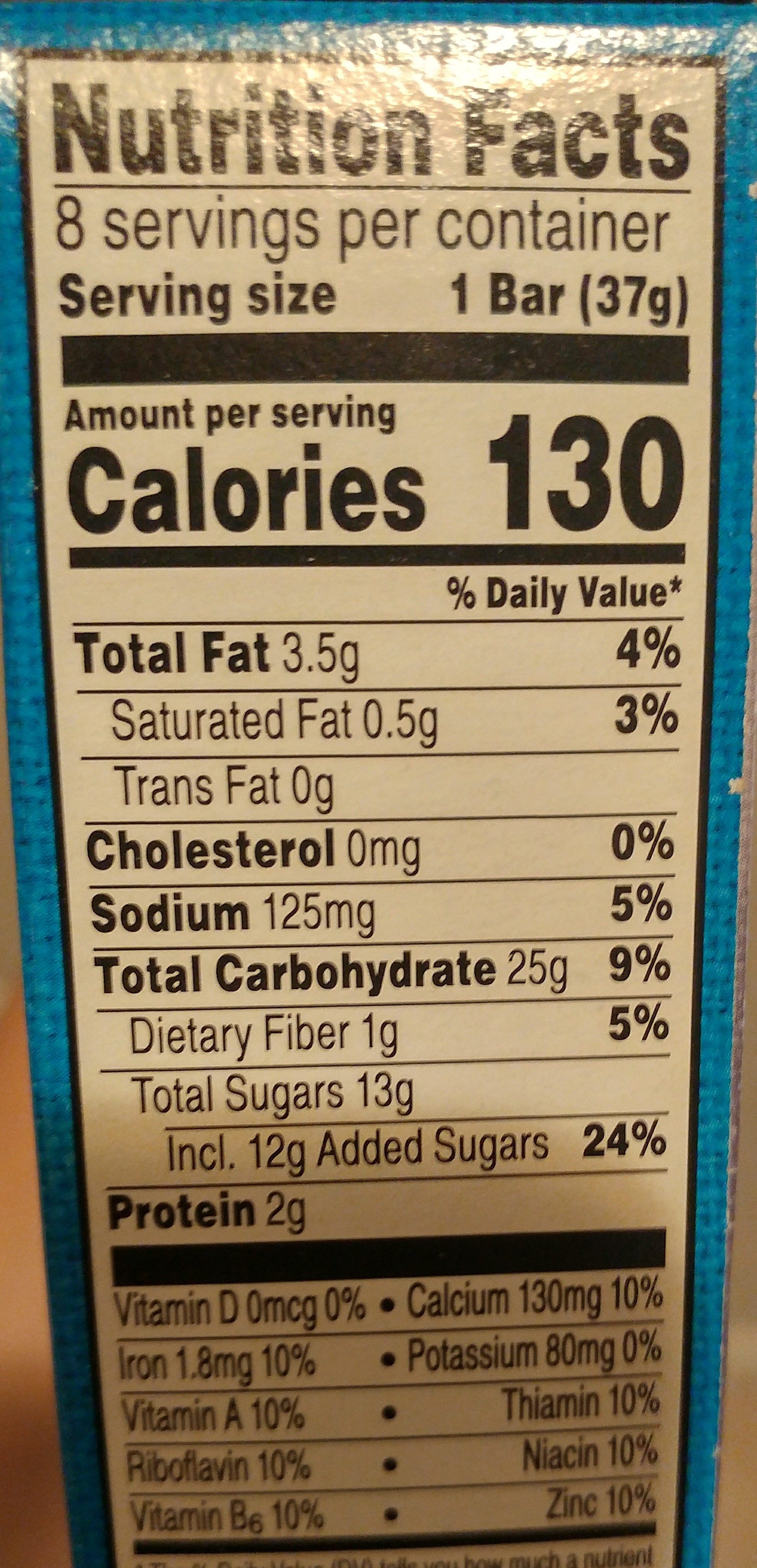Help us make food transparency the norm!
As a non-profit organization, we depend on your donations to continue informing consumers around the world about what they eat.
The food revolution starts with you!
Blueberry soft baked breakfast bars - Kellogg's - 8 bars (37 grams)
Blueberry soft baked breakfast bars - Kellogg's - 8 bars (37 grams)
This product page is not complete. You can help to complete it by editing it and adding more data from the photos we have, or by taking more photos using the app for Android or iPhone/iPad. Thank you!
×
Barcode: 0038000357008 (EAN / EAN-13) 038000357008 (UPC / UPC-A)
Quantity: 8 bars (37 grams)
Packaging: Bag, Box, Cardboard, Individual bag
Brands: Kellogg's
Brand owner: The Kellogg Company
Categories: Snacks, Sweet snacks, Bars, Cereal bars
Labels, certifications, awards: No artificial flavors
Countries where sold: United States
Matching with your preferences
Health
Ingredients
-
57 ingredients
crust: whole grain oats, enriched flour (wheat flour, niacin, reduced iron, vitamin b1 [thiamin mononitrate], vitamin b2 [riboflavin], folic acid), soybean oil, whole wheat flour, sugar, dextrose, fructose, calcium carbonate, vegetable glycerin, invert sugar, whey, soluble corn fiber, salt, wheat bran, cellulose, natural flavors, potassium bicarbonate, mono - and diglycerides, soy lecithin, wheat gluten, niacinamide, vitamin a palmitate, carrageenan, zinc oxide, reduced iron, guar gum, vitamin b6 (pyridoxine hydrochloride), vitamin b1 (thiamin hydrochloride), vitamin b2 (riboflavin), filling: invert sugar, corn syrup, blueberry puree concentrate, vegetable glycerin, sugar, modified food starch, sodium alginate, natural flavors, citric acid, sodium citrate, vegetable juice for color, methylcellulose, dicalcium phosphate, malic acid, apple juice concentrateAllergens: Gluten, Milk, Soybeans
Food processing
-
Ultra processed foods
Elements that indicate the product is in the 4 - Ultra processed food and drink products group:
- Additive: E322 - Lecithins
- Additive: E401 - Sodium alginate
- Additive: E407 - Carrageenan
- Additive: E412 - Guar gum
- Additive: E422 - Glycerol
- Additive: E460 - Cellulose
- Additive: E461 - Methyl cellulose
- Additive: E471 - Mono- and diglycerides of fatty acids
- Ingredient: Dextrose
- Ingredient: Flavouring
- Ingredient: Glucose
- Ingredient: Gluten
- Ingredient: Invert sugar
- Ingredient: Whey
Food products are classified into 4 groups according to their degree of processing:
- Unprocessed or minimally processed foods
- Processed culinary ingredients
- Processed foods
- Ultra processed foods
The determination of the group is based on the category of the product and on the ingredients it contains.
Additives
-
E296 - Malic acid
Malic acid: Malic acid is an organic compound with the molecular formula C4H6O5. It is a dicarboxylic acid that is made by all living organisms, contributes to the pleasantly sour taste of fruits, and is used as a food additive. Malic acid has two stereoisomeric forms -L- and D-enantiomers-, though only the L-isomer exists naturally. The salts and esters of malic acid are known as malates. The malate anion is an intermediate in the citric acid cycle.Source: Wikipedia
-
E322 - Lecithins
Lecithins are natural compounds commonly used in the food industry as emulsifiers and stabilizers.
Extracted from sources like soybeans and eggs, lecithins consist of phospholipids that enhance the mixing of oil and water, ensuring smooth textures in various products like chocolates, dressings, and baked goods.
They do not present any known health risks.
-
E322i - Lecithin
Lecithins are natural compounds commonly used in the food industry as emulsifiers and stabilizers.
Extracted from sources like soybeans and eggs, lecithins consist of phospholipids that enhance the mixing of oil and water, ensuring smooth textures in various products like chocolates, dressings, and baked goods.
They do not present any known health risks.
-
E330 - Citric acid
Citric acid is a natural organic acid found in citrus fruits such as lemons, oranges, and limes.
It is widely used in the food industry as a flavor enhancer, acidulant, and preservative due to its tart and refreshing taste.
Citric acid is safe for consumption when used in moderation and is considered a generally recognized as safe (GRAS) food additive by regulatory agencies worldwide.
-
E341 - Calcium phosphates
Calcium phosphate: Calcium phosphate is a family of materials and minerals containing calcium ions -Ca2+- together with inorganic phosphate anions. Some so-called calcium phosphates contain oxide and hydroxide as well. They are white solids of nutritious value.Source: Wikipedia
-
E341ii - Dicalcium phosphate
Calcium phosphate: Calcium phosphate is a family of materials and minerals containing calcium ions -Ca2+- together with inorganic phosphate anions. Some so-called calcium phosphates contain oxide and hydroxide as well. They are white solids of nutritious value.Source: Wikipedia
-
E407 - Carrageenan
Carrageenan (E407), derived from red seaweed, is widely employed in the food industry as a gelling, thickening, and stabilizing agent, notably in dairy and meat products.
It can exist in various forms, each imparting distinct textural properties to food.
However, its degraded form, often referred to as poligeenan, has raised health concerns due to its potential inflammatory effects and its classification as a possible human carcinogen (Group 2B) by the International Agency for Research on Cancer (IARC).
Nevertheless, food-grade carrageenan has been deemed safe by various regulatory bodies when consumed in amounts typically found in food.
-
E412 - Guar gum
Guar gum (E412) is a natural food additive derived from guar beans.
This white, odorless powder is valued for its remarkable thickening and stabilizing properties, making it a common ingredient in various food products, including sauces, dressings, and ice creams.
When used in moderation, guar gum is considered safe for consumption, with no known adverse health effects.
-
E422 - Glycerol
Glycerol: Glycerol -; also called glycerine or glycerin; see spelling differences- is a simple polyol compound. It is a colorless, odorless, viscous liquid that is sweet-tasting and non-toxic. The glycerol backbone is found in all lipids known as triglycerides. It is widely used in the food industry as a sweetener and humectant and in pharmaceutical formulations. Glycerol has three hydroxyl groups that are responsible for its solubility in water and its hygroscopic nature.Source: Wikipedia
-
E460 - Cellulose
Cellulose: Cellulose is an organic compound with the formula -C6H10O5-n, a polysaccharide consisting of a linear chain of several hundred to many thousands of β-1→4- linked D-glucose units. Cellulose is an important structural component of the primary cell wall of green plants, many forms of algae and the oomycetes. Some species of bacteria secrete it to form biofilms. Cellulose is the most abundant organic polymer on Earth. The cellulose content of cotton fiber is 90%, that of wood is 40–50%, and that of dried hemp is approximately 57%.Cellulose is mainly used to produce paperboard and paper. Smaller quantities are converted into a wide variety of derivative products such as cellophane and rayon. Conversion of cellulose from energy crops into biofuels such as cellulosic ethanol is under development as a renewable fuel source. Cellulose for industrial use is mainly obtained from wood pulp and cotton.Some animals, particularly ruminants and termites, can digest cellulose with the help of symbiotic micro-organisms that live in their guts, such as Trichonympha. In human nutrition, cellulose is a non-digestible constituent of insoluble dietary fiber, acting as a hydrophilic bulking agent for feces and potentially aiding in defecation.Source: Wikipedia
-
E461 - Methyl cellulose
Methyl cellulose: Methyl cellulose -or methylcellulose- is a chemical compound derived from cellulose. It is a hydrophilic white powder in pure form and dissolves in cold -but not in hot- water, forming a clear viscous solution or gel. It is sold under a variety of trade names and is used as a thickener and emulsifier in various food and cosmetic products, and also as a treatment of constipation. Like cellulose, it is not digestible, not toxic, and not an allergen.Source: Wikipedia
-
E471 - Mono- and diglycerides of fatty acids
Mono- and diglycerides of fatty acids (E471), are food additives commonly used as emulsifiers in various processed foods.
These compounds consist of glycerol molecules linked to one or two fatty acid chains, which help stabilize and blend water and oil-based ingredients. E471 enhances the texture and shelf life of products like margarine, baked goods, and ice cream, ensuring a smooth and consistent texture.
It is generally considered safe for consumption within established regulatory limits.
Ingredients analysis
-
May contain palm oil
Ingredients that may contain palm oil: E471
-
Non-vegan
Non-vegan ingredients: WheySome ingredients could not be recognized.
We need your help!
You can help us recognize more ingredients and better analyze the list of ingredients for this product and others:
- Edit this product page to correct spelling mistakes in the ingredients list, and/or to remove ingredients in other languages and sentences that are not related to the ingredients.
- Add new entries, synonyms or translations to our multilingual lists of ingredients, ingredient processing methods, and labels.
If you would like to help, join the #ingredients channel on our Slack discussion space and/or learn about ingredients analysis on our wiki. Thank you!
-
Vegetarian status unknown
Unrecognized ingredients: Reduced iron, Thiamin, Thiamin mononitrate, Folic acid, Vegetable-glycerin, Invert sugar, Zinc oxide, Reduced iron, Thiamin, Thiamin hydrochloride, Invert sugar, Vegetable-glycerin, Sodium citrate, Vegetable-juice-for-colorSome ingredients could not be recognized.
We need your help!
You can help us recognize more ingredients and better analyze the list of ingredients for this product and others:
- Edit this product page to correct spelling mistakes in the ingredients list, and/or to remove ingredients in other languages and sentences that are not related to the ingredients.
- Add new entries, synonyms or translations to our multilingual lists of ingredients, ingredient processing methods, and labels.
If you would like to help, join the #ingredients channel on our Slack discussion space and/or learn about ingredients analysis on our wiki. Thank you!
-
Details of the analysis of the ingredients
We need your help!
Some ingredients could not be recognized.
We need your help!
You can help us recognize more ingredients and better analyze the list of ingredients for this product and others:
- Edit this product page to correct spelling mistakes in the ingredients list, and/or to remove ingredients in other languages and sentences that are not related to the ingredients.
- Add new entries, synonyms or translations to our multilingual lists of ingredients, ingredient processing methods, and labels.
If you would like to help, join the #ingredients channel on our Slack discussion space and/or learn about ingredients analysis on our wiki. Thank you!
: crust (whole grain oats), flour (wheat flour, niacin, reduced iron, vitamin b1 (thiamin mononitrate), vitamin b2 (riboflavin), folic acid), soybean oil, whole wheat flour, sugar, dextrose, fructose, calcium carbonate, vegetable glycerin, invert sugar, whey, soluble corn fiber, salt, wheat bran, cellulose, natural flavors, potassium bicarbonate, mono- and diglycerides, soy lecithin, wheat gluten, niacinamide, vitamin a palmitate, carrageenan, zinc oxide, reduced iron, guar gum, vitamin b6 (pyridoxine hydrochloride), vitamin b1 (thiamin hydrochloride), vitamin b2 (riboflavin), filling (invert sugar), corn syrup, blueberry, vegetable glycerin, sugar, modified food starch, sodium alginate, natural flavors, citric acid, sodium citrate, vegetable juice for color, methylcellulose, dicalcium phosphate, malic acid, apple juice- crust -> en:crust - vegan: maybe - vegetarian: maybe - percent_min: 2.27272727272727 - percent_max: 100
- whole grain oats -> en:wholemeal-oat - vegan: yes - vegetarian: yes - ciqual_food_code: 9310 - percent_min: 2.27272727272727 - percent_max: 100
- flour -> en:flour - vegan: yes - vegetarian: yes - ciqual_proxy_food_code: 9410 - percent_min: 0 - percent_max: 50
- wheat flour -> en:wheat-flour - vegan: yes - vegetarian: yes - ciqual_proxy_food_code: 9410 - percent_min: 0 - percent_max: 50
- niacin -> en:e375 - vegan: maybe - vegetarian: maybe - percent_min: 0 - percent_max: 25
- reduced iron -> en:reduced-iron - percent_min: 0 - percent_max: 16.6666666666667
- vitamin b1 -> en:thiamin - percent_min: 0 - percent_max: 12.5
- thiamin mononitrate -> en:thiamin-mononitrate - percent_min: 0 - percent_max: 12.5
- vitamin b2 -> en:e101 - vegan: maybe - vegetarian: yes - percent_min: 0 - percent_max: 10
- riboflavin -> en:e101 - vegan: maybe - vegetarian: yes - percent_min: 0 - percent_max: 10
- folic acid -> en:folic-acid - percent_min: 0 - percent_max: 8.33333333333333
- soybean oil -> en:soya-oil - vegan: yes - vegetarian: yes - from_palm_oil: no - ciqual_food_code: 17420 - percent_min: 0 - percent_max: 33.3333333333333
- whole wheat flour -> en:whole-wheat-flour - vegan: yes - vegetarian: yes - ciqual_proxy_food_code: 9410 - percent_min: 0 - percent_max: 25
- sugar -> en:sugar - vegan: yes - vegetarian: yes - ciqual_proxy_food_code: 31016 - percent_min: 0 - percent_max: 20
- dextrose -> en:dextrose - vegan: yes - vegetarian: yes - ciqual_proxy_food_code: 31016 - percent_min: 0 - percent_max: 16.6666666666667
- fructose -> en:fructose - vegan: yes - vegetarian: yes - ciqual_food_code: 31077 - percent_min: 0 - percent_max: 14.2857142857143
- calcium carbonate -> en:e170i - vegan: maybe - vegetarian: maybe - percent_min: 0 - percent_max: 12.5
- vegetable glycerin -> en:vegetable-glycerin - percent_min: 0 - percent_max: 11.1111111111111
- invert sugar -> en:invert-sugar - percent_min: 0 - percent_max: 10
- whey -> en:whey - vegan: no - vegetarian: maybe - percent_min: 0 - percent_max: 9.09090909090909
- soluble corn fiber -> en:soluble-corn-fiber - vegan: yes - vegetarian: yes - percent_min: 0 - percent_max: 8.33333333333333
- salt -> en:salt - vegan: yes - vegetarian: yes - ciqual_food_code: 11058 - percent_min: 0 - percent_max: 0.878
- wheat bran -> en:wheat-bran - vegan: yes - vegetarian: yes - ciqual_food_code: 9621 - percent_min: 0 - percent_max: 0.878
- cellulose -> en:e460 - vegan: yes - vegetarian: yes - percent_min: 0 - percent_max: 0.878
- natural flavors -> en:natural-flavouring - vegan: maybe - vegetarian: maybe - percent_min: 0 - percent_max: 0.878
- potassium bicarbonate -> en:e501ii - vegan: yes - vegetarian: yes - percent_min: 0 - percent_max: 0.878
- mono- and diglycerides -> en:e471 - vegan: maybe - vegetarian: maybe - from_palm_oil: maybe - percent_min: 0 - percent_max: 0.878
- soy lecithin -> en:soya-lecithin - vegan: yes - vegetarian: yes - ciqual_food_code: 42200 - percent_min: 0 - percent_max: 0.878
- wheat gluten -> en:wheat-gluten - vegan: yes - vegetarian: yes - percent_min: 0 - percent_max: 0.878
- niacinamide -> en:e375 - vegan: maybe - vegetarian: maybe - percent_min: 0 - percent_max: 0.878
- vitamin a palmitate -> en:retinyl-palmitate - vegan: yes - vegetarian: yes - percent_min: 0 - percent_max: 0.878
- carrageenan -> en:e407 - vegan: yes - vegetarian: yes - percent_min: 0 - percent_max: 0.878
- zinc oxide -> en:zinc-oxide - percent_min: 0 - percent_max: 0.878
- reduced iron -> en:reduced-iron - percent_min: 0 - percent_max: 0.878
- guar gum -> en:e412 - vegan: yes - vegetarian: yes - percent_min: 0 - percent_max: 0.878
- vitamin b6 -> en:vitamin-b6 - vegan: yes - vegetarian: yes - percent_min: 0 - percent_max: 0.878
- pyridoxine hydrochloride -> en:pyridoxine-hydrochloride - vegan: yes - vegetarian: yes - percent_min: 0 - percent_max: 0.878
- vitamin b1 -> en:thiamin - percent_min: 0 - percent_max: 0.878
- thiamin hydrochloride -> en:thiamin-hydrochloride - percent_min: 0 - percent_max: 0.878
- vitamin b2 -> en:e101 - vegan: maybe - vegetarian: yes - percent_min: 0 - percent_max: 0.878
- riboflavin -> en:e101 - vegan: maybe - vegetarian: yes - percent_min: 0 - percent_max: 0.878
- filling -> en:filling - vegan: maybe - vegetarian: maybe - percent_min: 0 - percent_max: 0.878
- invert sugar -> en:invert-sugar - percent_min: 0 - percent_max: 0.878
- corn syrup -> en:corn-syrup - vegan: yes - vegetarian: yes - ciqual_proxy_food_code: 31089 - percent_min: 0 - percent_max: 0.878
- blueberry -> en:blueberry - vegan: yes - vegetarian: yes - ciqual_food_code: 13028 - percent_min: 0 - percent_max: 0.878
- vegetable glycerin -> en:vegetable-glycerin - percent_min: 0 - percent_max: 0.878
- sugar -> en:sugar - vegan: yes - vegetarian: yes - ciqual_proxy_food_code: 31016 - percent_min: 0 - percent_max: 0.878
- modified food starch -> en:modified-starch - vegan: yes - vegetarian: yes - ciqual_proxy_food_code: 9510 - percent_min: 0 - percent_max: 0.878
- sodium alginate -> en:e401 - vegan: yes - vegetarian: yes - percent_min: 0 - percent_max: 0.878
- natural flavors -> en:natural-flavouring - vegan: maybe - vegetarian: maybe - percent_min: 0 - percent_max: 0.878
- citric acid -> en:e330 - vegan: yes - vegetarian: yes - percent_min: 0 - percent_max: 0.878
- sodium citrate -> en:sodium-citrate - percent_min: 0 - percent_max: 0.878
- vegetable juice for color -> en:vegetable-juice-for-color - percent_min: 0 - percent_max: 0.878
- methylcellulose -> en:e461 - vegan: yes - vegetarian: yes - percent_min: 0 - percent_max: 0.878
- dicalcium phosphate -> en:e341ii - vegan: yes - vegetarian: yes - percent_min: 0 - percent_max: 0.878
- malic acid -> en:e296 - vegan: yes - vegetarian: yes - percent_min: 0 - percent_max: 0.878
- apple juice -> en:apple-juice - vegan: yes - vegetarian: yes - ciqual_food_code: 2074 - percent_min: 0 - percent_max: 0.878
Nutrition
-
Poor nutritional quality
⚠ ️Warning: the amount of fruits, vegetables and nuts is not specified on the label, it was estimated from the list of ingredients: 0This product is not considered a beverage for the calculation of the Nutri-Score.
Positive points: 2
- Proteins: 3 / 5 (value: 5.41, rounded value: 5.41)
- Fiber: 2 / 5 (value: 2.7, rounded value: 2.7)
- Fruits, vegetables, nuts, and colza/walnut/olive oils: 0 / 5 (value: 2.27650147621716e-08, rounded value: 0)
Negative points: 15
- Energy: 4 / 10 (value: 1470, rounded value: 1470)
- Sugars: 7 / 10 (value: 35.1, rounded value: 35.1)
- Saturated fat: 1 / 10 (value: 1.35, rounded value: 1.4)
- Sodium: 3 / 10 (value: 351, rounded value: 351)
The points for proteins are not counted because the negative points are greater or equal to 11.
Nutritional score: (15 - 2)
Nutri-Score:
-
Nutrient levels
-
Fat in moderate quantity (9.46%)
What you need to know- A high consumption of fat, especially saturated fats, can raise cholesterol, which increases the risk of heart diseases.
Recommendation: Limit the consumption of fat and saturated fat- Choose products with lower fat and saturated fat content.
-
Saturated fat in low quantity (1.35%)
What you need to know- A high consumption of fat, especially saturated fats, can raise cholesterol, which increases the risk of heart diseases.
Recommendation: Limit the consumption of fat and saturated fat- Choose products with lower fat and saturated fat content.
-
Sugars in high quantity (35.1%)
What you need to know- A high consumption of sugar can cause weight gain and tooth decay. It also augments the risk of type 2 diabetes and cardio-vascular diseases.
Recommendation: Limit the consumption of sugar and sugary drinks- Sugary drinks (such as sodas, fruit beverages, and fruit juices and nectars) should be limited as much as possible (no more than 1 glass a day).
- Choose products with lower sugar content and reduce the consumption of products with added sugars.
-
Salt in moderate quantity (0.878%)
What you need to know- A high consumption of salt (or sodium) can cause raised blood pressure, which can increase the risk of heart disease and stroke.
- Many people who have high blood pressure do not know it, as there are often no symptoms.
- Most people consume too much salt (on average 9 to 12 grams per day), around twice the recommended maximum level of intake.
Recommendation: Limit the consumption of salt and salted food- Reduce the quantity of salt used when cooking, and don't salt again at the table.
- Limit the consumption of salty snacks and choose products with lower salt content.
-
-
Nutrition facts
Nutrition facts As sold
for 100 g / 100 mlAs sold
per serving (1 BAR (37 g))Compared to: Cereal bars Energy 1,470 kj
(351 kcal)544 kj
(130 kcal)-16% Fat 9.46 g 3.5 g -39% Saturated fat 1.35 g 0.5 g -74% Trans fat 0 g 0 g -100% Cholesterol 0 mg 0 mg -100% Carbohydrates 67.6 g 25 g +15% Sugars 35.1 g 13 g +37% Fiber 2.7 g 1 g -58% Proteins 5.41 g 2 g -33% Salt 0.878 g 0.325 g +115% Alcohol 0 % vol 0 % vol Vitamin A 405 µg 150 µg (10 % DV) +198% Vitamin C (ascorbic acid) 0 mg 0 mg -100% Vitamin B1 (Thiamin) 0.324 mg 0.12 mg (10 % DV) -86% Vitamin B2 (Riboflavin) 0.459 mg 0.17 mg (10 % DV) -19% Vitamin B3/PP (Niacin) 5.41 mg 2 mg (10 % DV) -26% Vitamin B6 (Pyridoxin) 0.541 mg 0.2 mg (10 % DV) -5% Potassium 216 mg 80 mg -4% Calcium 351 mg 130 mg +108% Iron 4.86 mg 1.8 mg +40% Zinc 4.05 mg 1.5 mg (10 % DV) +144% Fruits‚ vegetables‚ nuts and rapeseed‚ walnut and olive oils (estimate from ingredients list analysis) 0 % 0 %
Environment
-
Eco-Score not computed - Unknown environmental impact
We could not compute the Eco-Score of this product as it is missing some data, could you help complete it?Could you add a precise product category so that we can compute the Eco-Score? Add a category
Packaging
-
Packaging with a medium impact
-
Packaging parts
1 x Box (Cardboard)
8 x Individual bag
-
Packaging materials
Material % Packaging weight Packaging weight per 100 g of product Paper or cardboard
-
Transportation
-
Origins of ingredients
Missing origins of ingredients information
⚠ ️ The origins of the ingredients of this product are not indicated.
If they are indicated on the packaging, you can modify the product sheet and add them.
If you are the manufacturer of this product, you can send us the information with our free platform for producers.Add the origins of ingredients for this product Add the origins of ingredients for this product
Report a problem
-
Incomplete or incorrect information?
Category, labels, ingredients, allergens, nutritional information, photos etc.
If the information does not match the information on the packaging, please complete or correct it. Open Food Facts is a collaborative database, and every contribution is useful for all.
Data sources
Product added on by labeleat
Last edit of product page on by strongbeard.
Product page also edited by inf, kiliweb, labeleat.hVRm7FXPthifN0340D2EuFMNL8a1, openfoodfacts-contributors, org-database-usda, roboto-app, yuka.V3BndUQ0MWJqUGtud1BGZzFRL0kyWUpMbG9PWlVrU01MTUFNSWc9PQ.
